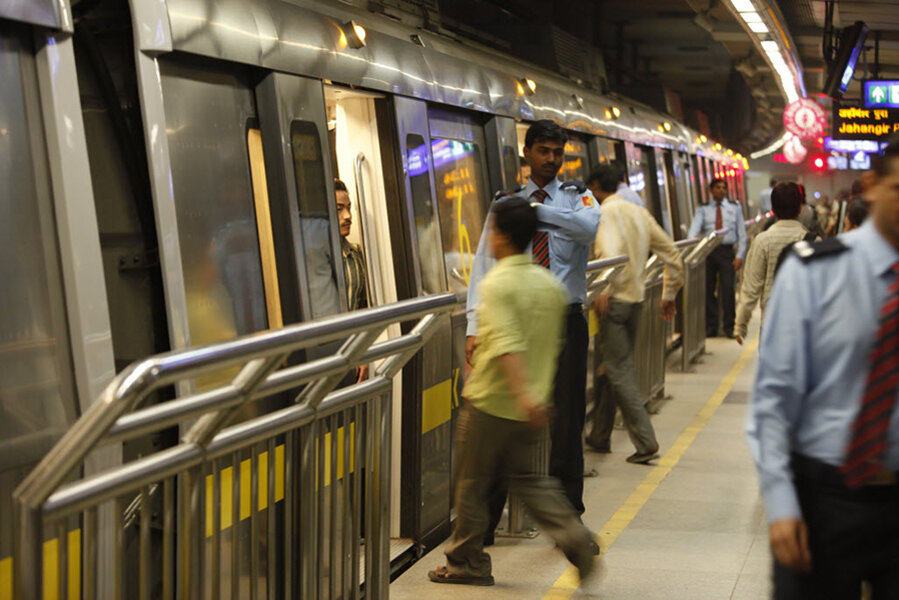India's driverless Metro: Unlike cars, robo-trains are hurtling forward
Loading...
Soon, stepping onto a Delhi Metro train in India could mean taking a ride controlled entirely automatically, with no operator onboard.
The Delhi Metro Corporation – which operates one of the world’s largest systems, spanning 132 miles – unveiled its plans for an automated train on Wednesday.
For their first year, human operators will control the trains, fitted with cameras and sensors to take the place of a driver, the Times of India reports.
“We can expect to travel in a driverless train by the end of next year," said Mangu Singh, managing director of the government-funded system, at a news conference Wednesday. “The trains will be controlled from operation centers, and a strict watch will be maintained over their running.”
While the move toward driverless cars in the US has progressed slowly, with companies citing regulatory tangles and lawmakers pointing to safety concerns, many parts of the world already offer fully or partially autonomous public transportation.
“Tracks – especially dedicated tracks – are an important simplifier that automated road vehicles don't enjoy,” says Bryant Walker Smith, an assistant professor at the University of South Carolina School of Law, who studies the technology, in an email to The Christian Science Monitor.
But transit workers say the impact on jobs, and on services provided to riders, could be significant.
"If they’re talking about automating the systems and removing the personnel, that works in a perfect place like in Disneyland, where the worst thing that can be happen is you can be late for your ride or for your Belgian waffle," says Lawrence Hanley, international president of the Amalgamated Transit Union, which represents workers in the US and Canada.
"But if they do it on a subway where people are really commuting to and from their work and their schools," he continues, "they expose the public to anything to anybody might do on that train with absolutely nobody in charge." Transit workers often serve as first responders when emergencies occur, he says.
While fully automated trains operated on only 6 percent of the world’s total railway transit length in 2013, according to researchers from Imperial College London, several large systems, including the Copenhagen Metro, lines in Vancouver, São Paulo, Dubai, Paris, Seoul and parts of Italy and Japan can all operate completely automatically.
Honolulu has also been working toward the first major automated system in the US. Professor Smith also points to the use of automated trains at airports around the world, including in many major US cities.
Proponents point to a number of benefits, including making trains more reliable, providing between 4 and 6 percent more room for passengers, and improving the spacing between trains – known as headway – that can improve the experience for riders waiting on the platform for the next train.
The Delhi Metro’s move to fully automated trains, which will be rolled out over the course of the year, is expected to accommodate 40 more passengers in a car, along with additional accommodations for people with disabilities.
To maintain safety, the Delhi Metro will have an obstruction deflection device that can push away small obstacles on the track and three CCTV cameras that can be viewed by operators in a central control room, reports the Press Trust of India.
The new cars will also boast USB ports, LED screens with an interactive route map, and Wi-Fi access – which the Indian government has pushed for at railway stations across the country, Mr. Singh said. They’re also expected to reduce the system's energy consumption, the Times reports.
Last year, the Imperial College researchers surveyed 23 highly-automated systems, and found that two of the systems with the highest frequency of trains – 42 every hour – were both fully automated.
They say that switching to fully automated trains could save up to 70 percent of staffing costs, potentially allowing train operators to focus on improving their operations.
But transit workers point to the unpredictable nature of situations many transit systems encounter.
In London, Mayor Boris Johnson has been engaged in a long-running battle with workers' unions, who have protested working conditions in a series of strikes, most recently this summer.
But Mr. Johnson has stood by his promise that the Underground – which already includes some partially automated trains – will introduce trains capable of running without a driver by 2020.
In 2012, the National Union of Rail, Maritime and Transit Workers, the country’s largest transit union, protested a trial of automated trains on the Underground’s Jubilee line, describing it as “political.”
A leaked transit agency document uncovered by the Evening Standard suggests that despite Johnson’s promise, the new trains won’t be driverless until a decade later.
Mr. Hanley, of the transit union, says that training a computer to learn to anticipate unusual situations or an emergency is as much a challenge for a train as for a self-driving car, leading to potential safety concerns for passengers and workers.
"As you start to get dogs running across the track, or big rats like they have in New York, or fires, a human being is prepared for the unexpected and knows how to respond. Computers have to see the same situation again and again before they’re actually trained to respond to that," he says.
But Smith argues those changes come with the territory. He draws a contrast with autopilot systems on planes, which – despite some passengers’ beliefs – are not designed to fly planes at all times or replace pilots.
“Of course these systems change the number and nature of transit jobs. Every significant technological development has employment implications,” he says.







